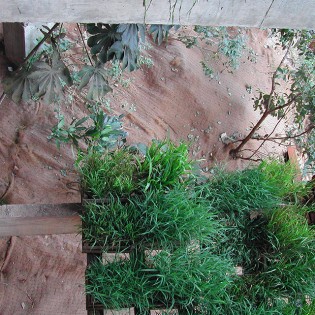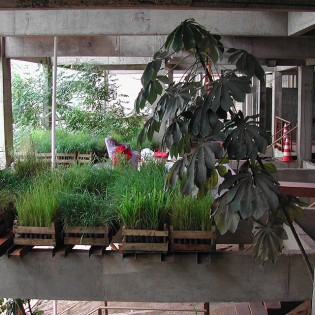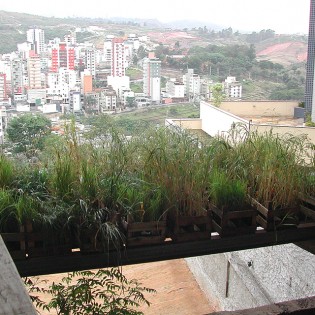Topographical Amnesias II was complemented by landscaping, when common and vulgar plants invaded the stilts. Hanging gardens, wooden platforms and a large coconut fiber surface lined the entire hillside. The coconut fiber screen was more than just an inducer of a plant cover. It transformed that landscape of rubble and debris into a scenographic topography, embracing the entire slope until descending to the ground below, occupying the entire vacant lot as if it were a carpet of grass shoots. The entire surface of the ground was wrapped by the screen and everything was like concave and convex hills of fibrous coconut generating, according to critic Ana Luiza Nobre, “a great mantle from which life begins to sprout”.
In addition to this agricultural surface, the weeds climbed up the beams to reach the heights of the stilts. Pine boxes, the same ones used to transport fruit, were used to plant more weeds. There were 180 boxes with 28 seedlings in each (or 5.040 seedlings), occupying an area of 100 m2 and supported on “I” trusses. Birdseed and corn – grasses known to be fast – reached 50 centimeters after just one month of life. Rice and ‘meloso’ grass, a little slower, were important to generate variations in texture and tones (they have lighter greens), in addition to causing interesting volumetric nuances in the suspended scrub. Other invasive and/or edible plants taken to the stilts: ryegrass (Lolium multiflorum), oats (Bromus catharticus), rice (Luziola peruviana), brachiaria (Brachiara decumbens) and honey grass (Melinis minutif lora).
See also the essay Amnésias Topográficas in Vitruvius, an online journal.
Photos: Eduardo Eckenfels, Bruno Magalhães, Carlos Teixeira














